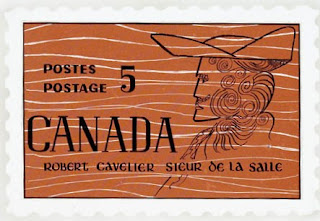 René-Robert Cavelier, Sieur de La Salle, (1643 – 1687) explored the Great Lakes, the Mississipi River and the Gulf of Mexico, claiming the entire Mississippi River basin for France. La Salle's expeditions began in the late 1660s until 1687 . The expeditions led to the establishment of an overland trade route connecting French colonies in Canada with French colonies in Louisiana.
René-Robert Cavelier, Sieur de La Salle, (1643 – 1687) explored the Great Lakes, the Mississipi River and the Gulf of Mexico, claiming the entire Mississippi River basin for France. La Salle's expeditions began in the late 1660s until 1687 . The expeditions led to the establishment of an overland trade route connecting French colonies in Canada with French colonies in Louisiana.The Canadian Museum of Civilization's website has an excellent article devoted to La Salle, (linked October 21,2010). The Museum's article describes a man of questionable honesty, skills, and leadership abilities. La Salle's last expedition, to found a colony up the Mississipi, ended in his murder at the hands of his own men. A statue of La Salle was erected in Navasota, Texas, where it was believed La Salle was killed.
This excerpt from The Canadian Encyclopedia describes the expedition (linked October 21, 2010):
"Given command of the expedition, he displayed incompetence and paranoia...Most of the expedition's supplies having been lost and the Indians alienated, starvation loomed. In April 1686 La Salle set off with 20 men to seek help at Fort St-Louis-des-Illinois. Dissension in his party and at the base resulted in desertion and murder, and finally in the assassination of La Salle. The wonder is that his men had not killed him long before. A romantic hero to 19th-century historians, La Salle was in fact a victim of his own incapacities."
Canada Post Office issued the La Salle stamp on April 13, 1966. The stamp was designed by Leendert Verhoven of Brigdens Limited, a Toronto graphic arts company.
Graphic Material

National Archives of Canada
National Archives of Canada
National Archives of Canada
National Archives of Canada
National Archives of Canada
National Archives of Canada
National Archives of Canada
National Archives of Canada
National Archives of Canada
National Archives of Canada
First Day Covers

Sherring Corporation

The Shering cachet shows La Salle's expeditions:

Chickering/Jackson

The Chickering cachet captured La Salle's significant accomplishment:
"Explored the Mississipi River to its mouth"



Canada Post Office Announcement First Day Cover

Canada Post Office used its two-flag cachet to mail the La Salle announcement. This cover was mailed to Portugal.




First Day Covers

Sherring Corporation

The Shering cachet shows La Salle's expeditions:

Chickering/Jackson

The Chickering cachet captured La Salle's significant accomplishment:
"Explored the Mississipi River to its mouth"



Canada Post Office Announcement First Day Cover

Canada Post Office used its two-flag cachet to mail the La Salle announcement. This cover was mailed to Portugal.














